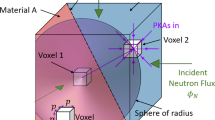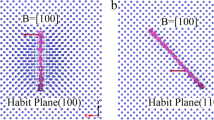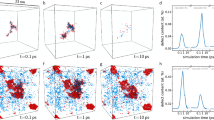Abstract
Changes in microstructure and mechanical properties of nuclear materials are governed by the kinetics of defects produced by irradiation. The population of vacancies, interstitials and their clusters can however be followed only indirectly, for example by macroscopic resistivity measurements. The information on the mobility, recombination, clustering or dissociation of defects provided by such experiments is both extremely rich and difficult to interpret. By combining ab initio and kinetic Monte Carlo methods, we successfully reproduce the abrupt resistivity changes—so-called recovery stages—observed upon annealing at increasing temperatures after electron irradiation in α-iron. New features in the mechanisms responsible for these stages are revealed. We show that di-vacancies and tri-interstitials contribute to the stages attributed to mono-vacancy and di-interstitial migration respectively. We also predict the effect of the unexpected low migration barriers found for tri- and quadri-vacancies, and discuss the challenging questions raised by the mobility of larger defect clusters.
This is a preview of subscription content, access via your institution
Access options
Subscribe to this journal
Receive 12 print issues and online access
$259.00 per year
only $21.58 per issue
Buy this article
- Purchase on Springer Link
- Instant access to full article PDF
Prices may be subject to local taxes which are calculated during checkout






Similar content being viewed by others
References
Seeger, A., Schumacher, D., Schilling, W. & Diehl, J. (eds) Vacancies and Interstitials in Metals (Elsevier, North-Holland, 1970).
Díaz de la Rubia, T. et al. Multiscale modelling of plastic flow localization in irradiated materials. Nature 406, 871–874 (2000).
Averback, R. S. & Díaz de la Rubia, T. Displacement damage in irradiated metals and semiconductors. Solid State Phys. 51, 281–402 (1998).
Lanore, J. M. Simulation de l'évolution des défauts dans un réseau par la méthode de Monte Carlo. Radiat. Eff. 22, 153–162 (1974).
Dalla Torre, J., Bocquet, J.-L., Doan, N. V., Adam, E. & Barbu, A. Jerk, an event-based kinetic Monte Carlo model to predict microstructure evolution of materials under irradiation. Phil. Mag. (in the press).
Soler, J. M. et al. The SIESTA method for ab-initio order-N materials simulation. J. Phys. Condens. Matter. 14, 2745–2779 (2002).
Fu, C. C., Willaime, F. & Ordejón, P. Stability and mobility of mono- and di-interstitials in α-Fe. Phys. Rev. Lett. 92, 175503 (2004).
Takaki, S., Fuss, J., Kugler, H., Dedek, U. & Schultz, H. The resistivity recovery of high purity and carbon doped iron following low temperature electron irradiation. Radiat. Eff. 79, 87–122 (1983).
Blythe, H. J., Kronmüller, H., Seeger, A. & Walz, F. A review of the magnetic relaxation and its application in the study of atomic defects in α-iron and its diluted alloys. Phys. Status Solidi A 181, 233–345 (2000).
Vascon, R. & Doan, N. V. Molecular dynamics simulations of displacement cascades in α-iron. Radiat. Eff. Defects Solids 141, 375–384 (1997).
Soneda, N. & Díaz de la Rubia, T. Defect production, annealing kinetics and damage evolution in α-Fe: an atomic-scale simulation. Phil. Mag. A 78, 995–1019 (1998).
Bacon, D. J., Gao, F. & Osetsky, Y. N. The primary damage state in fcc, bcc, and hcp metals as seen in molecular dynamics simulations. J. Nucl. Mater. 276, 1–12 (2000).
Soneda, N. & Díaz de la Rubia, T. Migration kinetics of the self-interstitial atom and its cluster in bcc Fe. Phil. Mag. A 81, 331–343 (2001).
Marian, J. et al. Dynamics of self-interstitial cluster migration in pure α-Fe and Fe–Cu alloys. Phys. Rev. B 65, 144102 (2002).
Marian, J., Wirth, B. D. & Perlado, J. M. Mechanism of formation and growth of <100> interstitial loops in ferritic materials. Phys. Rev. Lett. 88, 255507 (2002).
Mendelev, M. I. et al. Development of new interatomic potentials appropriate for crystalline and liquid iron. Phil. Mag. 83, 3977–3994 (2003).
Telling, R. H., Ewels, C. P., El-Barbary, A. A. & Heggie, M. I. Wigner defects bridge the graphite gap. Nature Mater. 2, 333–337 (2003).
Domain, C. & Becquart, C. S. Ab initio calculations of defects in Fe and dilute Fe–Cu alloys. Phys. Rev. B 65, 024103 (2001).
Johnson, R. A. Interstitials and vacancies in α iron. Phys. Rev. 134, A1329–A1336 (1964).
Beeler, J. R. & Johnson, R. A. Vacancy clusters in α-iron. Phys. Rev. 156, 677–684 (1967).
Becquart, C. S. & Domain, C. Ab initio contribution to the study of complexes formed during dilute FeCu alloys radiation. Nucl. Instrum. Meth. B 202, 44–50 (2003).
Hardouin Duparc, A., Moingeon, C., Smetniansky-de-Grande, N. & Barbu, A. Microstructure modelling of ferritic alloys under high flux 1 MeV electron irradiations. J. Nucl. Mater. 302, 143–155 (2002).
Schwendemann, B., Kronmüller, H. & Walz, F. Investigation of stage III in electron-irradiated α-iron. Cryst. Latt. Def. Amorph. Mater. 11, 1–14 (1985).
Verdone, J., Moser, P., Hautojärvi, P., Johanson, J. & Vehanen, A. in Internal Friction and Ultrasonic Attenuation in Solids (ed. Smith, C.), 205–210 (Pergamon, Oxford, 1980).
Matsui, H., Takehana, S. & Guinan, M. W. Resistivity recovery in high purity iron after fission- and fusion-neutron irradiation. J. Nucl. Mater. 155–157, 1284–1289 (1988).
Ward, A. E. & Fischer, S. B. Dislocation loop growth in pure iron under electron irradiation. J. Nucl. Mater. 166, 227–234 (1989).
Robinson, T. M. Xenon ion irradiation of α-Fe. Phys. Status Solidi A 75, 243–249 (1983).
Caturla, M. J. et al. Comparative study of radiation damage accumulation in Cu and Fe. J. Nucl. Mater. 276, 13–21 (2000).
Marian, J. et al. Direct comparison between modeling and experiment: an α-Fe ion implantation study. Mater. Res. Soc. Symp. Proc. 650, R3.2.1–6 (2001).
Pelfort, M., Osetsky, Y. N. & Serra, A. Vacancy interaction with glissile interstitial clusters in bcc metals. Phil. Mag. Lett. 81, 803–811 (2001).
Eyre, B. L. & Bullough, R. On the formation of interstitial loops in bcc metals. Phil. Mag. 12, 31–35 (1965).
Brailsford, A. D., Bullough, R. & Hayns, M. Point defect sink strengths and void-swelling. J. Nucl. Mater. 60, 246–256 (1976).
Ordejón, P. Linear scaling ab-initio calculations in nanoscale materials with SIESTA. Phys. Status Solidi B 217, 335–356 (2000).
Maurice, F. & Doan, N. V. Simulation de l'évolution de populations de défauts dans un cristal par la méthode de Monte Carlo. Tech. Rep. CEA-R-5101 (1981).
Maury, F., Biget, M., Vajda, P. & Lucasson, A. Anisotropy of defect creation in electron irradiated iron crystals. Phys. Rev. B 14, 5303–5313 (1976).
Barbu, A., Becquart, C. S., Bocquet, J.-L., Dalla Torre, J. & Domain, C. Comparison between three complementary approaches to simulate large fluence irradiation: application to electron irradiation of thin foils. Phil. Mag. (in the press).
Acknowledgements
We thank G. Martin for discussions, G. Landa and P. Bellon for a critical reading of the manuscript and N. V. Doan and E. Adam for help in visualization codes. This work was supported by the PERFECT European Integrated Project under Contract No. FI6O-CT-2003-508840 and by the joint research program SMIRN between EDF, CEA and CNRS.
Author information
Authors and Affiliations
Corresponding author
Ethics declarations
Competing interests
The authors declare no competing financial interests.
Rights and permissions
About this article
Cite this article
Fu, CC., Torre, J., Willaime, F. et al. Multiscale modelling of defect kinetics in irradiated iron. Nature Mater 4, 68–74 (2005). https://doi.org/10.1038/nmat1286
Received:
Accepted:
Published:
Issue Date:
DOI: https://doi.org/10.1038/nmat1286
This article is cited by
-
Attain insensitivity to chlorine ions in magnesium alloys by impeding the diffusion process
npj Materials Degradation (2024)
-
Machine learning potential assisted exploration of complex defect potential energy surfaces
npj Computational Materials (2024)
-
Phase patterning of metallic glasses through superfast quenching of ion irradiation-induced thermal spikes
Nano Convergence (2023)
-
The kinetics of static recovery by dislocation climb
npj Computational Materials (2022)
-
Direct imaging of the disconnection climb mediated point defects absorption by a grain boundary
Nature Communications (2022)



